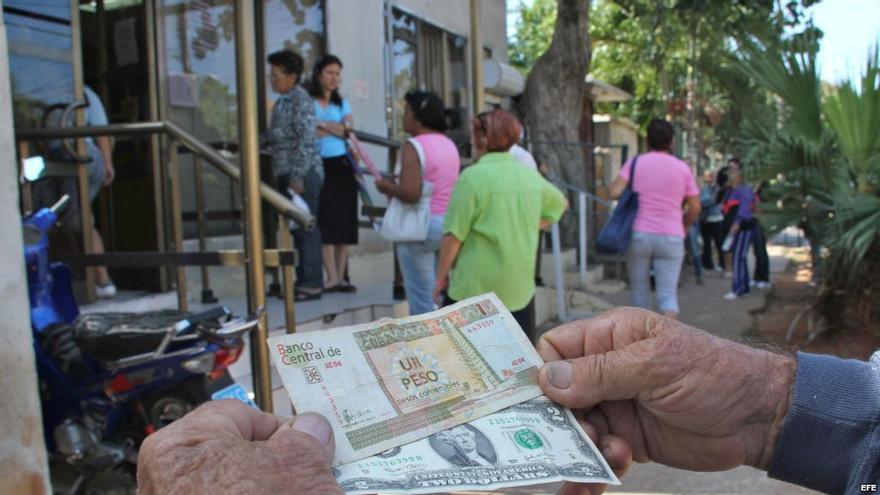
![]() 14ymedio, Eugenio Yáñez, 22 August 2018 — In “socialist” Cuba, nobody is surprised by the marvelous reality or the magical realism of everyday life.
14ymedio, Eugenio Yáñez, 22 August 2018 — In “socialist” Cuba, nobody is surprised by the marvelous reality or the magical realism of everyday life.
In this relatively small country there are three currencies and several exchange rates, in addition to five different forms of property according to the constitutional reform project, despite which, or precisely because of this nonsense, the economy has not worked properly for six decades.
The US dollar circulates in Cuba, which is the true measure of the value of things in the country.
The Cuban convertible peso (CUC) circulates, supposedly “equal to the dollar,” but in reality its value disappears beyond Cuba’s coasts. In a certain sense, the CUC is reminiscent of the “wet foot/dry foot” policy: on Cuban soil, (“dry foot”) it is accepted and circulates; beyond the coasts (“wet foot”) is neither valid nor accepted.
And a third currency circulates, the Cuban peso (CUP), the one with which the Government pays its employees, who are the majority of the country’s workers. But those Cuban pesos, devalued for more than 25 years, never stretch far enough to satisfy the most basic needs of the population.
As if that were not enough, within the country different exchange rates between these currencies work legally, and the esoteric Castro regime accounting is hocus-pocus, trying to record transactions decently, but the only thing it achieves is making mistakes and not controlling anything. Because although the official exchange is 1 dollar to 1 CUC (which in turn equals 24 or 25 CUP), in practice tourists visiting the country receive 0.87 CUC for every dollar delivered to the currency exchanges.
Meanwhile, importing companies, thanks to sibylline accounting techniques, when they import, let’s say, raw materials for national production, even if the payment is made in euros, yen, or sterling, they will be accounted for in US dollars at a rate of 1 dollar for 1 CUP, that is, with a different exchange rate from that in the market.
Thus, if raw material was purchased for an equivalent of one million dollars, the official accounting will register a cost of that import as 1 million CUP, which is totally and absolutely false, because with 1 million CUP one can only get $40,000 at the official rate of 1 dollar for 25 CUP. And if at the end of the production cycle the company that used these raw materials achieved a supposed net profit of 10 million CUP, it will be a pretend triumph that will stand out impressively in the official press, filled with congratulations for the business group and its leaders.
Although there is a “small detail” that the official press would not take into account: those 10 million CUP in supposed profits really amount to 400,000 dollars at the real exchange rate in Cuba. So, if that “triumphant” company had used $1 million in raw material and in the end it shows a supposed profit of a million CUP, in reality during that productive cycle it would have had losses of $600,000 instead of the vaunted benefit of $400,000.
The supposed productive achievement is due to the conceptual barbarism (trademarked by Castroism) by which accounting works in Cuba, more typical of Macondo* than of a serious nation in the 21st century.
There is more. Workers of foreign companies, both in the Mariel Special Development Zone and in other economic activities, are paid at a rate of 2 CUP for every dollar of salary. In an act of immorality and illegality the parasitic State collects the dollar from the foreign entity, and passes on the equivalent of 8 cents to the employee, taking away from the Cuban worker practically 92% of his salary.
In contrast, to stimulate the supply of meat, fruit and vegetables for tourism, the farmers and cooperatives that supply the Varadero resort have an established rate of exchange of 1 dollar for 7 CUP for each dollar of fresh agricultural products destined for tourism that they sell to the State. It is probable that this mechanism will also be applied in the other tourist resorts on the Island, to limit the imports of these products from the Bahamas or Jamaica.
In other specific activities related to foreign companies, exchange rates equivalent to 1 dollar per 10 CUP are mentioned.
Faced with these realities, it does not do much for the Government to meet constantly or for the President to visit here or there day after day, if the cardinal problems are not addressed and no real solution is sought.
Why talk about so many less important things in the meetings of the Government and the Party, if the issues of monetary duality or unreliable accounting are not touched on?
With these two thorns stuck in the heart of the national economy, you can’t even dream that things will improve. Not recognizing it can only be because of immorality or ignorance. Or for both reasons.
*Translator’s note: Macondo is the fictional town in Gabriel Garcia Marquez’s “One Hundred Years of Solitude.”
________________________
The 14ymedio team is committed to serious journalism that reflects the reality of deep Cuba. Thank you for joining us on this long road. We invite you to continue supporting us, but this time by becoming a member of 14ymedio. Together we can continue to transform journalism in Cuba.
